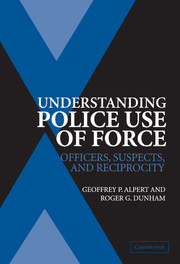Book contents
- Frontmatter
- Contents
- Acknowledgments
- Introduction: The Context of Police Use of Force
- 1 Police Use of Force: The History of Research
- 2 The Crucial Element: Finding Research Sites
- 3 Findings from Miami-Dade Police Department Study
- 4 The Sequential Steps in Use-of-Force Incidents in the Miami-Dade Police Department
- 5 Miami-Dade Police Department: Inconsistencies between Officer and Suspect Accounts of the Use of Force
- 6 Findings from Prince George's County Police Department
- 7 Findings and Summary
- 8 Explaining Police Use of Force: The Breakdown of an Authority Maintenance Ritual
- Appendix: Frequencies of Force Sequences for First through Tenth Actions
- Index
- References
3 - Findings from Miami-Dade Police Department Study
Published online by Cambridge University Press: 14 July 2009
- Frontmatter
- Contents
- Acknowledgments
- Introduction: The Context of Police Use of Force
- 1 Police Use of Force: The History of Research
- 2 The Crucial Element: Finding Research Sites
- 3 Findings from Miami-Dade Police Department Study
- 4 The Sequential Steps in Use-of-Force Incidents in the Miami-Dade Police Department
- 5 Miami-Dade Police Department: Inconsistencies between Officer and Suspect Accounts of the Use of Force
- 6 Findings from Prince George's County Police Department
- 7 Findings and Summary
- 8 Explaining Police Use of Force: The Breakdown of an Authority Maintenance Ritual
- Appendix: Frequencies of Force Sequences for First through Tenth Actions
- Index
- References
Summary
this and the following two chapters include descriptions and analyses of information provided by the Miami-Dade Police Department (MDPD). This chapter reports the general findings from the MDPD control-of-persons reports, and should be read in conjunction with Chapter 4, which includes an analysis of the sequential actions of officers and suspects during encounters, and Chapter 5, which reviews the inconsistencies in reports from officers and suspects. The Miami-Dade Police Department provided complete access to their use-of-force and officer personnel files. Their cooperation allowed for a comprehensive review and analysis of all the use-of-force and personnel data and was instrumental in allowing the formulation of the framework given in Chapter 8, a framework that underpins this book.
The data set from MDPD includes information from 1,038 official Miami-Dade Police Department control-of-persons reports from the years 1996, 1997, and 1998 (Table 3-1). These data are reported by the officer's supervisor after talking to the officer, suspect, and available witnesses. The department's computerized information and an analysis of the written reports were used to create the data set. Although differences existed between officer and suspect versions in 12 percent of the cases (Chapter 7), the analyses of computerized forms and the Force Factor calculations relied on the “official” version as reported by the supervisor.
We begin our analysis of the Miami-Dade Police Department Control of Persons Reports with information on suspect characteristics and actions, then discuss arresting officer characteristics and actions, and analyses of the interaction patterns between officer and suspect.
- Type
- Chapter
- Information
- Understanding Police Use of ForceOfficers, Suspects, and Reciprocity, pp. 65 - 86Publisher: Cambridge University PressPrint publication year: 2004



